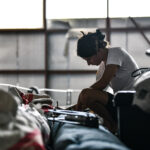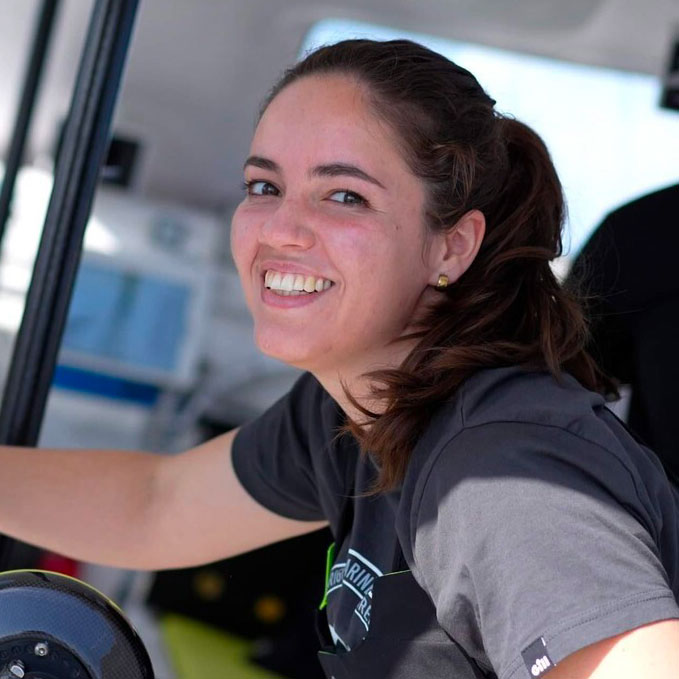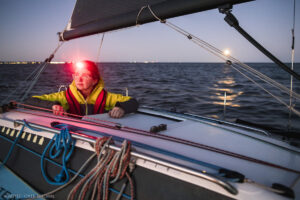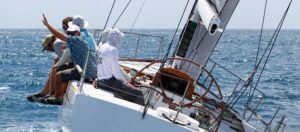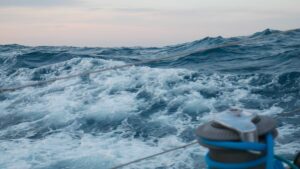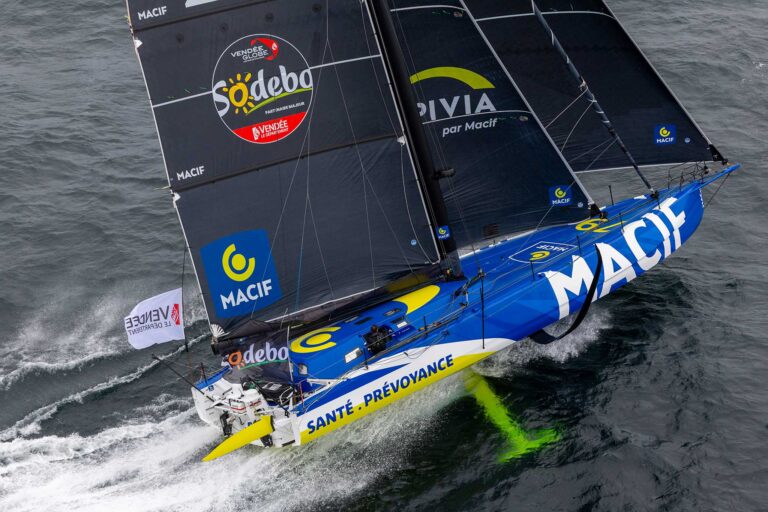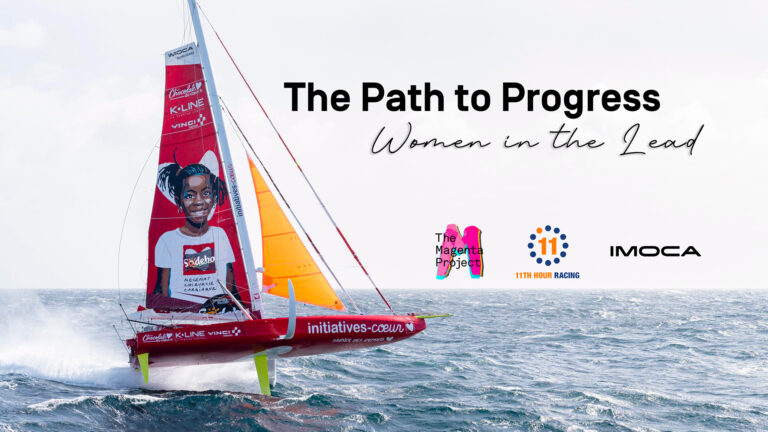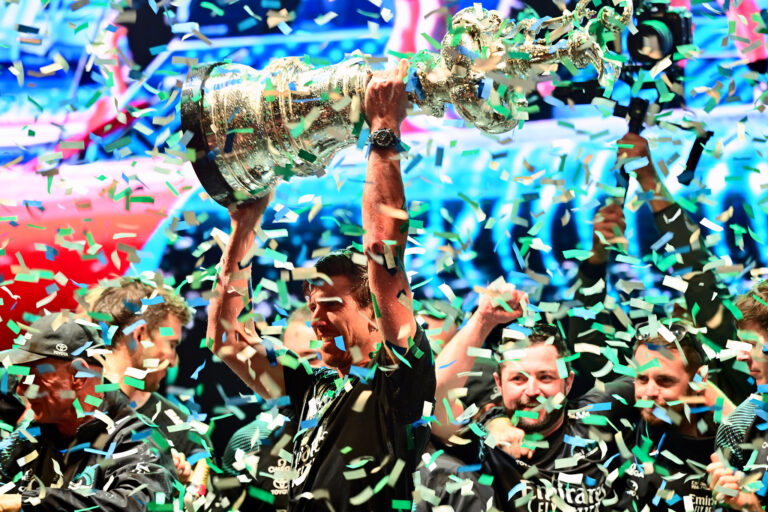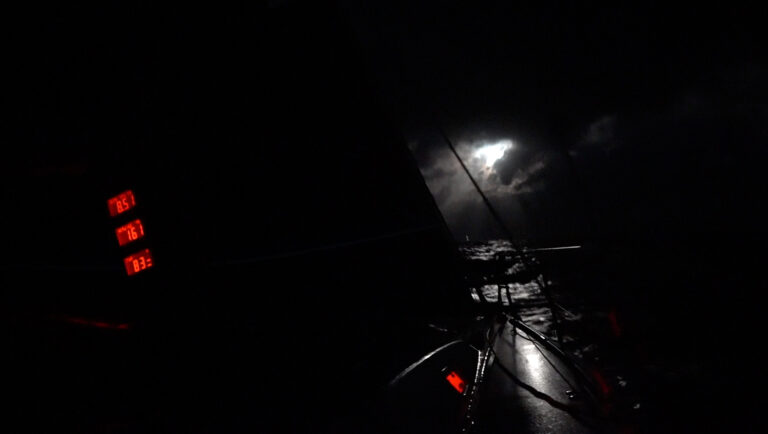
Sailing hasn’t been a sport of the masses during Cole Brauer’s lifetime. In fact, there’s a full generation of young adults who grew up after the United States’ America’s Cup golden age, after the era when non-sailors and national media followed the sport. Solo ocean racing in particular has always been the purview of the French, and with a few notable exceptions rarely has showcased Americans, let alone as front runners gaining celebrity status.
So, it was a surprise to many of us when Cole’s Instagram account rocketed from 10,000 to nearly half a million followers over a handful of months in late 2023 and early 2024. She was competing in the Global Solo Challenge, a solo, nonstop, round-the-world race, and her daily updates quickly captured the attention of the masses. In less than six months, she went from relatively unknown to being featured in The New York Times, People magazine, and on The Today Show.

In the interest of full disclosure, I’ll mention that I have spent recent months working double duty as SAIL’s managing editor from 9-5 and as Cole’s media manager from 5-9. (Literally. Depending on where in the world she is and what hours of daylight that corresponds with, my work has rotated around the clock.)
But Cole didn’t set out to become a celebrity. She set out to prove a point. Her career as a professional sailor had seen the gamut from skepticism to outright dismissal. On smaller circuits, she found she was regularly paid less than her male counterparts, even when they were younger and less experienced than her. After trying out for an Ocean Race campaign in 2022, she was told that at 5 feet, 2 inches tall and 100 pounds, she was simply too small for the Southern Ocean.
“I’d always wanted to sail around the world before I turned 30,” Cole says. “I didn’t specifically want to do it on my own, but if no one was going to take a chance on me, I was going to have to go alone and prove them wrong.”
The proof of concept came in the form of winning the 2023 Bermuda 1-2 with co-skipper Cat Chimney, crossing the line more than 12 hours ahead of the next competitors in both legs and becoming the first all-female team to win the event. Cole had been captaining the Class40 First Light (formerly Dragon) long enough to know its strengths and weaknesses intimately, and when new owners offered to let her compete on the boat during the summer of 2023, she used all of that expertise to her advantage. The Bermuda 1-2 rocketed her to local renown.

“After the Bermuda 1-2, I was just planning to take some time off, but the boat’s owners were like ‘What’s next?’ ” she remembers. “They really encouraged me to dream bigger.”
Cole and I met in person for the first time in September 2023 when she was preparing First Light for the transatlantic shakedown that would take her to the start of the Global Solo Challenge. The shed of Safe Harbor Newport Shipyard was buzzing with activity in the late summer heat, and she took a break from packing the boat to give me and SAIL Editor-in-Chief Wendy Mitman Clarke a tour. What struck me most—more than her spirited demeanor, big dreams, or off-the-cuff expertise in all things First Light—was the loyalty she inspired in her team. Even then, before the race or the media spectacle started, she exuded a charisma that drew people in. That would become the hallmark of her campaign around the world.

The Global Solo Challenge began on August 26 when the first competitor, Dafydd Hughes, set out from A Coruña, Spain. The event was organized with a pursuit start, assigning each competitor a start date based on their boat’s speed rating. Cole’s race began two months later, on October 29, when she and six other competitors made up the largest starting cohort of the race. Of the 20 boats originally registered for the race, ultimately only 16 made it to the racecourse, and at press time only half were still in the running to reach the finish. There have been dismastings, autopilot failures, medical issues, and the constant looming pressure of the time gates meant to keep sailors on track and out of the Southern Ocean during the more dangerous months.
All that is to say that making it to the end of an event like the Global Solo Challenge is a feat on its own, before taking into account that upon finishing, Cole would become the first American woman to race solo nonstop around the world. As the youngest and only female skipper in the race, she was something of an oddity.
Before the race, she’d told me she wanted to be a different kind of ocean racer. “You see people in these races and they’re always so serious. They’re exhausted, they’re miserable. I don’t want to be like that. What’s the point in having an adventure like this if you’re not going to enjoy it?” I couldn’t argue with that logic. “I want to show people that they can have their dreams, and they can also find time to watch Netflix while they’re doing it. That it’s OK to take care of yourself and enjoy being out there.”
Cole’s painted nails, laundry days, on-deck dance parties, and bubbly demeanor certainly raised some eyebrows, but it also set her apart as a new kind of ocean racer, someone relatable and human. We watched the demographic breakdown of her Instagram followers closely in the early days of the race and noted that there were two kinds of people particularly captivated by her story, women her age, and men her parents’ age—the people who saw themselves in her, and the people who were most surprised to see someone like her doing what she was doing. Once again, she had something to prove.

It only took a few weeks to realize her account was a runaway train. Our shore team checked in every day to note the latest sailor she’d surpassed in followers. Olympians, Vendée Globe sailors, SailGP, the America’s Cup, her own mentors and role models…20,000 became 50,000, then 100,000. One day she had as many followers as an 11th Hour Racing Team sailor, and shortly after she had as many as the whole team combined.
And then there was no one left. We couldn’t find a single competitive sailor, campaign, or class with a bigger Instagram following than Cole. She’d cracked the social media code and, for the first time in a long time, a racer had crossed the line to mass appeal. Over and over again we heard people say, “I’m not a sailor, I don’t know how you ended up on my page, but I am so inspired by what you’re doing.”
The trade winds were gorgeous, the doldrums were brief, and aside from a stint with suspected food poisoning in the first week, life in the Atlantic suited Cole. For a month she dueled fellow American skipper Ronnie Simpson south, managing to stay ahead as they turned east and rounded the Cape of Good Hope.
That’s where the race’s drama took a turn, shifting from a sailing race to a boat-fixing race. Ronnie’s mainsail ripped. For Cole, first it was the autopilot, then a rudder reference. The former resulted in one particularly bad broach that tossed Cole across the boat, badly injuring her ribs in a car-crash-level impact. She lay still for a long while after, praying this wasn’t the end of her race, unsure if she’d be able to move if she tried.
All of it was captured by the on-board cameras.

We shared some of the footage of the incident online, but not all of it. Some of it was too violent, some too difficult to watch. But Cole had been candid about the highs and lows up until that point, and she wanted to be truthful with her viewers about how shaken she was by the incident.
“I’m OK, checked in with the medical team, the boat’s OK, everything’s fine, but you can never lose respect for the ocean, that is for sure,” she told them later that day.
It was about that time in the race that we saw an influx of what the team affectionately called “Cole’s internet parents.” The comments were full of worriers, advice givers, and cheerleaders. So proud of you! Where’s your tether? Haven’t seen an update today, is everything OK?
The follower demographics had shifted, equalizing across ages and genders, but the 55- to 65-year-old women were her champions. “I think for some of them, they see me out here following my dreams, and they didn’t have the opportunities that I have, so it means a lot to them to see me doing it,” Cole says.
As she navigated the cascading weather systems of the Southern Ocean, another issue cropped up. Her hydrogenerator started its rocky decline, needing days on end of maintenance and rebuilding. Ultimately, she was sailing too fast for the turbine, putting it in constant danger of overheating. But with no hydrogenerator and the dense cloud cover in the south, there was little power to spare. Cole had to ration her electricity, shutting down Starlink for stretches of time to make sure she could continue running her instruments or watermaker.

Sailors generally don’t expect to have constant connectivity between an offshore boat and those of us warm and dry at home, but Cole’s following wasn’t primarily made up of sailors. Reaching outside of the sailing world turned out to be a double-edged sword. Many of the followers were used to influencers whose main job was to create content, not professional athletes who were doing it as a fun side project mid-competiton. During the whole race she never went more than 24 hours without a post, but even that wasn’t enough to keep the worrying at bay.
On the approach to Cape Horn, Cole and her weather router, Chelsea Freas, made the tricky tactical decision that she should hold back for a day to position First Light just so in order to slalom two massive systems while rounding the most famously treacherous passage on Earth. During that time, she was in low-power mode, unsure when she’d be able to get back online. The tsunami of comments and questions was overwhelming, and Chelsea and I did our best to keep people calm and answer as many questions as possible, but we knew they wouldn’t be happy until they heard Cole’s chipper, “Good morning!” and saw her signature shaka again.
There was undoubtedly pressure on Cole to maintain constant flow of content, and most days I think it was a welcome creative outlet for her, helping to stave off isolation and monotony. But when things were stressful or the conditions were especially rough, it created a perfect storm of people having the most concerns just as Cole had the least bandwidth to assuage them.
As she continued the long slog north through the Atlantic, she was met with boat-breaking conditions—in some cases worse than the Southern Ocean because of the angle of the sea state or mountains of sargasso seaweed requiring near constant backdowns. In one week in late February, the race lost three competitors, including Ronnie, who was dismasted after days of battling intense storms in the south Atlantic. Five boats, a third of the fleet, retired in February. After more than 100 days at sea for most of them, it was hard to watch and a very real reminder that you can never get complacent.
From dancing on deck in a pink dress on New Year’s Eve to live streaming her rounding of Cape Horn, her race has been full of show-stopping moments, all of them rich with Cole’s signature brand of joie de vivre. But she never let documenting her adventure get in the way of actually sailing it. On the contrary, the fact that she was having fun kept her motivated and dialed in. She’d stayed ahead of the rest of the October 29th pack and spent the Indian Ocean picking off competitors one by one. By the time she passed south of Hobart where Dafydd was stopped for repairs, she’d climbed to second place on the leader board.
Cole was the youngest and only female skipper in the race.
Cole says being small doesn’t keep her from doing anything, she just needs to find her own way to do it sometimes.
She was able to live stream her Cape Horn rounding.
Cole’s success in the Bermuda 1-2 launched her into offshore racing fame.
Before the race kicked off, there was a lot of hard work to get the boat in shape.
Ultimately, Philippe Delamare’s Actual 46, Mowgli, proved uncatchable, completing the race on February 24 in 147 days. On March 7, Cole crossed the finish line second after sailing for 130 days. Even with an assigned start a whole month after Philippe, she made up half the difference. In addition to being the first American woman to race solo nonstop around the globe, Cole also set a new Class40 circumnavigation record, shaving seven days off the previous best.
Cole attributes much of her skill on the racecourse to having so many miles on First Light ahead of the race during her time as its captain. They are old friends. She can anticipate changes in the conditions or needed maintenance just by the changing sounds of the boat. Also in her corner is the financial backing of a private sponsor, which is particularly hard to come by for American sailors. Hopefully her success will help pave the way for more corporate interest in sponsoring future campaigns on this side of the Atlantic.
Another game changer on First Light was Starlink. We had near constant connection to her around the world save for the interruptions in her ability to power the system. This access would’ve been unimaginable just a decade ago.

There’s no doubt these technological advances have made it possible to showcase offshore sailing like never before, and Cole will be the first to tell you the connections she’s made with her supporters along the way have been some of the most joyful, touching parts of her adventure. But it does beg the question of whether her unprecedented success has set an impossible standard for the future of campaign media. Is it going to become the norm that these athletes must also be social media stars? And how will it change that delicate sponsorship ecosystem?
As for what’s next for Cole, she’s taking a little time off to catch her breath and adjust to her newfound fame. But she plans to be racing again by summer and is exploring the idea of upgrading to IMOCA 60 sailing with an eye towards launching a Vendée Globe campaign for another go around the world in a few years.
The Global Solo Challenge
The inaugural Global Solo Challenge sent sailors around the world via the three Great Capes, starting and finishing in A Coruña, Spain. Sixteen skippers set off over three months in late 2023, including three Americans. Competitors sailed solo but were allowed outside support and to stop for repairs, accruing a time penalty for the latter. Competitors could sail any kind of boat provided it was not purpose built for the race, making it a relatively budget-friendly event. However, the pursuit start aimed at correcting for different boatspeed potentials has drawn some criticism in part because, with three months separating the first and last start date, skippers faced vastly different conditions and seasonal weather. Still, it made for an exciting race with many close rivalries and high stakes routing decisions throughout.





